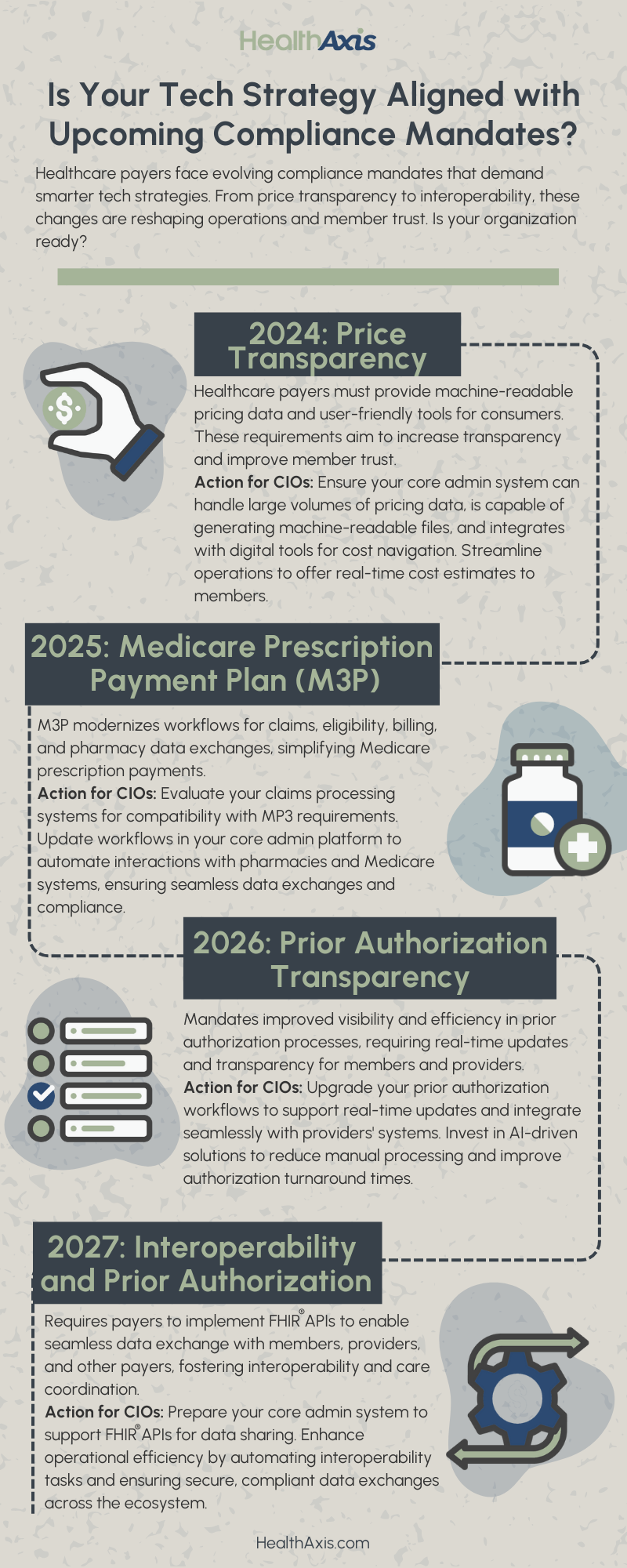In today’s dynamic healthcare landscape, operational efficiency and member retention are more interconnected than ever. The challenge lies in finding the right balance between automation and the human touch—leveraging innovative technology to manage routine tasks while reserving human expertise for meaningful interactions. According to MarketsandMarkets, the global artificial intelligence in healthcare market is projected to grow from $14.9 billion in 2024 to $164.2 billion by 2030, highlighting the increasing reliance on technology to drive improvements across the industry.¹
By investing in tools like artificial intelligence (AI), machine learning (ML), and robotic process automation (RPA), healthcare payers and third-party administrators (TPAs) can streamline operations, reduce errors, and free up their teams to focus on what truly matters: serving members with empathy and precision.
In this blog, we’ll explore three key areas where strategic investments in technology are driving healthcare operations towards the future:
- Reducing Cost and Errors in Claims Adjudication with AI and ML
- Advancing Workflow Efficiency with Robotic Process Automation (RPA)
- Redefining Call Center Operations with AI-Powered Tools
By focusing on these innovations, we will show how healthcare payers and TPAs can streamline repetitive processes, reduce costs, and free their teams to focus on delivering exceptional member experiences.
Taking Claims Adjudication to the Future with Reduced Processing Times, Lowered Costs
Investing in machine learning (ML) and artificial intelligence (AI) is transforming claims adjudication, streamlining processes, and improving outcomes for healthcare payers. Predictive models and intelligent algorithms are enabling organizations to achieve higher auto-adjudication (AA) rates, reduce processing times, and minimize disputes. By automating repetitive claims tasks, payers can decrease manual errors and labor costs while increasing accuracy.
For example, leveraging AI to identify discrepancies early in the process prevents costly errors and reduces downstream disputes with providers or suppliers. We anticipate a decline in disputes over time, particularly those related to settlement accuracy and appropriate reimbursement. These advancements allow human resources to focus on complex cases that require critical thinking and problem-solving—ensuring that when the human touch is needed, it truly makes an impact.
Reducing Manual Tasks to Improve Time and Accuracy
Robotic process automation (RPA) is revolutionizing how healthcare payers handle repetitive and manual tasks, creating opportunities for greater efficiency and accuracy. By deploying RPA bots, organizations can automate processes like managing 843 rejects, loading provider rosters, and matching authorizations on HCFA claims—tasks that previously consumed significant time and resources.
This shift reduces reliance on manual labor, lowers administrative costs, and minimizes the risk of human error. For example, automating 834 recheck management ensures consistency and accuracy while freeing staff to focus on high-value activities like solving complex member issues or improving operational workflows. The result is a more streamlined operation where resources are allocated to tasks that truly benefit from human expertise.
By utilizing RPA, HealthAxis more efficiently helps clients minimize costs and enhance administrative efficiency. For instance, automating claims processing significantly reduces manual intervention, ensuring near-perfect accuracy and faster reimbursements. This not only strengthens provider relationships but also lowers administrative labor costs.
Scaling the Call Center
Healthcare call centers handle an average of 2,000 calls daily. According to Dialog Health, peak staffing levels often meet only 60% of required coverage, creating a significant operational gap.² This shortfall can result in delays, frustration, and decreased satisfaction for patients seeking timely assistance. Addressing these challenges requires innovative solutions that optimize resources while maintaining high service standards.
AI is stepping in to bridge the gap by automating routine tasks and enhancing workforce management. AI-powered chatbots and digital assistants now handle common inquiries quickly and accurately, alleviating the burden on staff and ensuring members receive prompt, reliable information. Workforce management (WFM) tools further enhance efficiency by optimizing staff scheduling and improving agent performance.
HealthAxis is currently utilizing AI-driven voice technology built on voice large language model (LLM) infrastructure purpose-built for contact centers. This allows the interaction to be immediate, while still maintaining the conversational aspect. This system is designed to handle repetitive tasks such as checking claim status, providing coverage details, and scheduling appointments.
By automating repetitive interactions, healthcare organizations free their human representatives to focus on complex and emotionally sensitive member issues—tasks that truly benefit from empathy and critical thinking. This strategic use of AI ensures that operational efficiency does not come at the cost of personalized service, resulting in higher member retention and better resource utilization.
Reimagining Healthcare Through Innovation
Investing in AI, machine learning, and automation is more than just a strategy for improving efficiency—it’s a way to reimagine operations in healthcare. By automating routine tasks, payers can reduce costs, enhance accuracy, and free their teams to focus on what matters most: delivering meaningful, human-centered care to their members.
When organizations embrace forward-thinking technologies, they not only improve operational workflows but also create the space to build stronger, more empathetic connections with the people they serve. This is the future of healthcare—one where innovation and the human touch work hand in hand.
Connect with our experts to learn how HealthAxis is leveraging these innovations to transform healthcare operations and deliver exceptional results for our clients.
Author:

Nick Hutchins
Chief Growth Officer
Sources:
¹Markets and Markets, Artificial Intelligence (AI) in Healthcare Market, Growth, Size, Share and Trends
²Dialog Health, Latest Healthcare Call Center Statistics: Must-Know for 2025





















